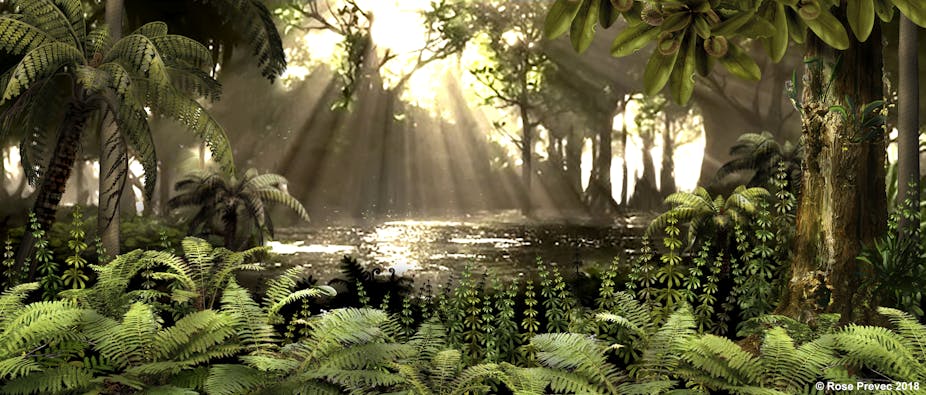There’s a particular feeling of excitement that comes from receiving a gift. It’s a feeling of the unknown, of anticipation – and then you unwrap the package and find something spectacular.
As palaeontologists, rocks are our idea of a great gift. That’s because when you crack them open, you might well find a fossil. And we aren’t talking about dinosaurs: our area of specialisation is palaeobotany. This involves hunting for plant fossils which can tell us a great deal about the landscapes of past ages.
South Africa is home to a range of lesser known and neglected plant fossils, called the glossopterids. These trees once grew in vast swamps along with ancient plant groups such as ferns, horsetail ferns and clubmosses. We know from a few scattered reports that this amazingly rich fossil resource extends across much of Africa, particularly in Namibia, Zimbabwe, Mozambique and further north into Zambia, Tanzania, Kenya and even Madagascar.
Some may wonder why fossils matter. Plants never get as much attention as South Africa’s famous rich and diverse fossil heritage that range from some of the earliest evidence of life through to its famous hominid collections. Glossopteris, for instance, has not been well studied in South Africa. It’s still poorly understood.
There has been work done in different parts of the world. However, it is not detailed and each region uses its own system to try and understand these fossil plants. South Africa is lagging behind: there are two employed palaeobotanists in the country, while entire research teams exist in other parts of the world.
Yet plants can reveal a great deal about past environments and climates. If we have any hope of understanding South Africa’s ancient past, scientists need to be able to reconstruct entire ecosystems, starting at the bottom of the food chain. Glossopteris dotted ancient landscapes before dinosaurs ever walked the earth, and before a single flower had bloomed. As such, it should be closely studied.
What we know
About 300 million years ago Earth entered what’s known as the Permian period. During this time, and until about 252 million years ago, the Glossopteris plant became a common sight throughout Gondwana. This was a super continent that included regions known today as Africa, Antarctica, Australia, India and South America.
The presence of Glossopteris was used as supporting evidence for the revolutionary theory of “continental drift” during the mid 20th century. They literally reveal how the world we recognise today took shape.
Glossopteris was easy to recognise because of its distinctive leaves; the name means “tongue-fern” in Greek, because of its shape. Fossil evidence suggests that the plants probably grew in diverse habitats and came in different forms. These ranged from short shrubs to trees as tall as a five-story building.
Scientists suggest that at least some of these plants were deciduous because their leaves are often found preserved in thick mats thought to be the result of seasonal shedding. At that point, they became not only important for understanding our history: they started contributing to fuels and materials that are still used today.
Power plants
Dead material from these plants accumulated in swamp environments, was buried, and over time formed South Africa’s vast coal reserves.
Under normal conditions, when plants die or shed their leaves these fall to the ground and decompose. Under special environmental conditions – such as those that occurred in the vast Permian swamps of Gondwana (which were a bit like today’s mangrove swamps) – the process differs. Once Glossopteris shed their leaves, the plant material accumulated in acidic water with high levels of tannins and low oxygen concentrations.
This retarded the activity of the bacteria, fungi and other organisms that would otherwise lead to decomposition. Over time layers of mud, silt and sand washed into the swamp and buried the waterlogged peat layers. Millions of years passed. During this period the mud, silt, sand and the encased plant material experienced great pressure and high temperatures. It was compressed and changed into rock, and underwent various chemical changes.
The result? Coal seams. This is why coal is referred to as a fossil fuel. It is also a reminder that coal is finite.
Apart from being the major source of fuel in the production of South Africa’s electricity, Glossopteris influences our lives in many ways. The carbon atoms harvested from the air as carbon dioxide by these trees during the process of photosynthesis, hundreds of millions of years ago, can also be found in petrol, waxes, plastics, and a host of other products used in everyday life.
New finds
South Africa has a huge potential for new fossil discoveries, with vast territories still waiting to be explored, yet very few researchers are studying fossil plants and insects.
We are part of a small group of researchers based at the Albany Museum in Grahamstown in the Eastern Cape province who are determined to change this by shedding more light on Glossopteris and fossil plants in general.
At the moment we’re working on a few small road cuttings near a Northern Cape town called Sutherland. This is revealing a depth of knowledge about Permian ecosystems that has not been seen before in South Africa, and is very rare on a global scale.
New discoveries are not only about bringing a wonderful piece of the country’s heritage to light. This work is also opening up new scientific fields and opportunities for skills development that the country desperately needs.

